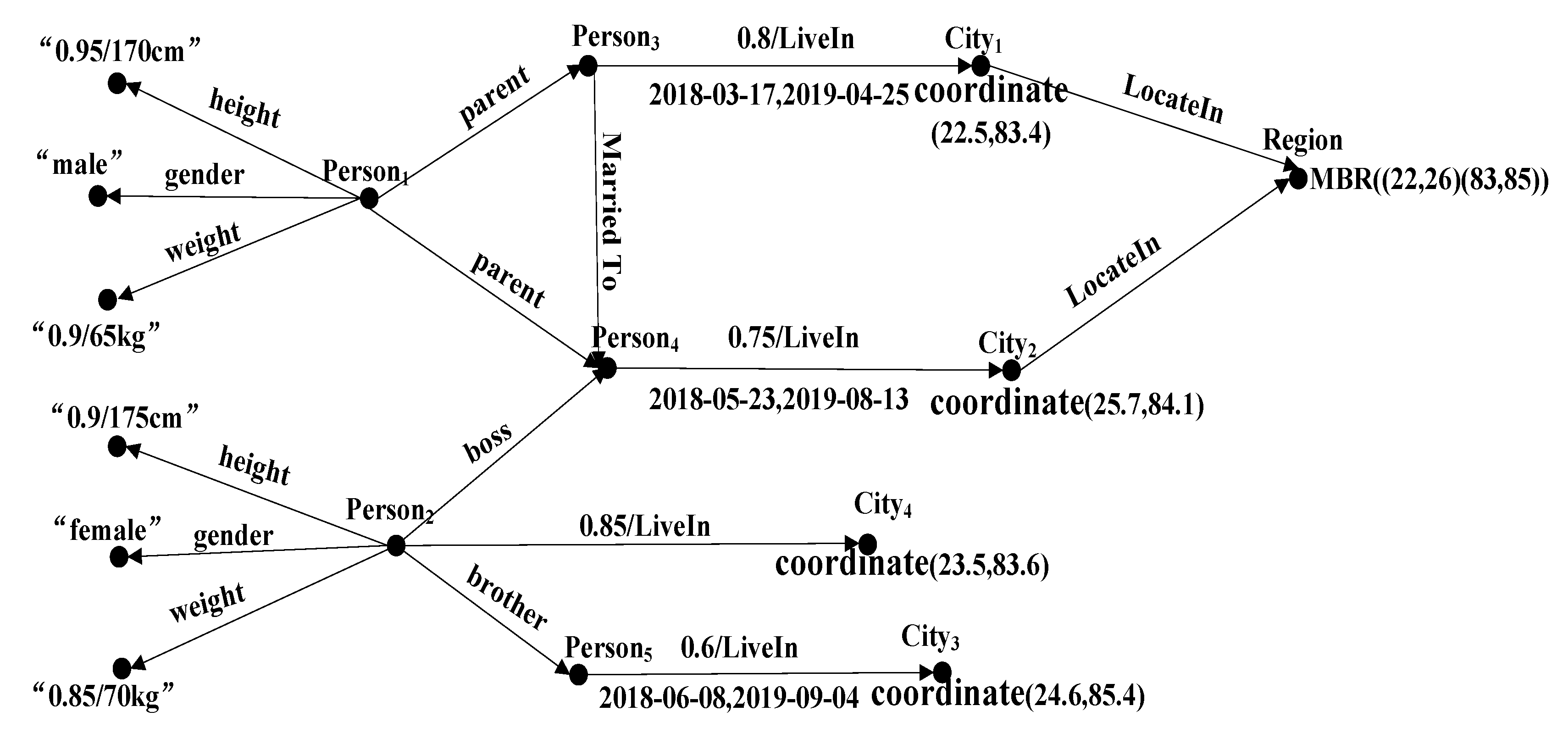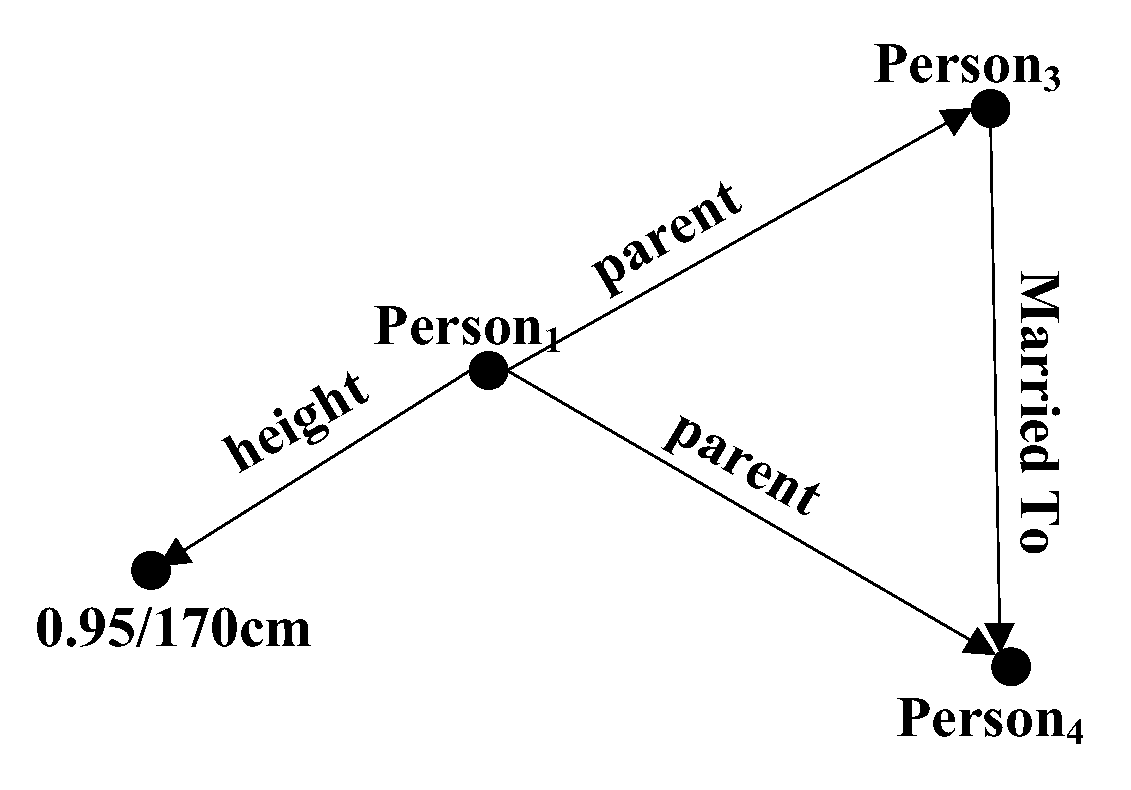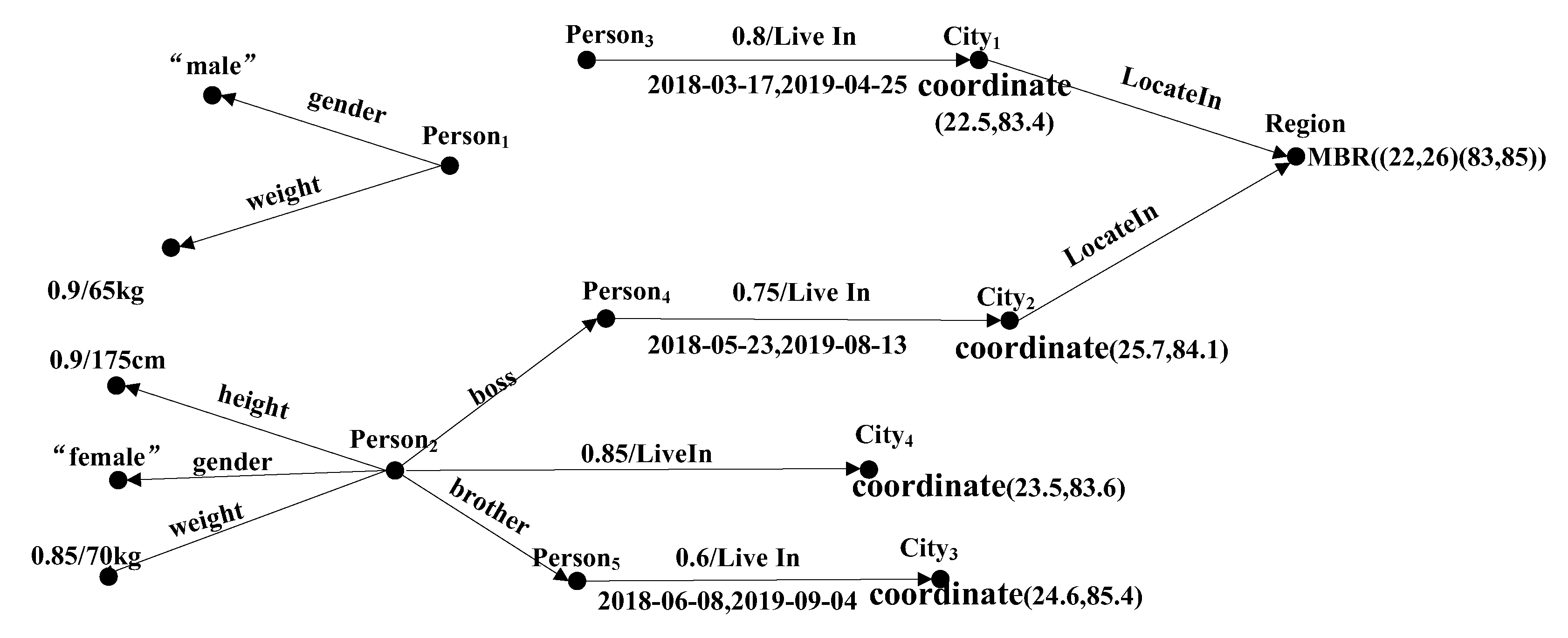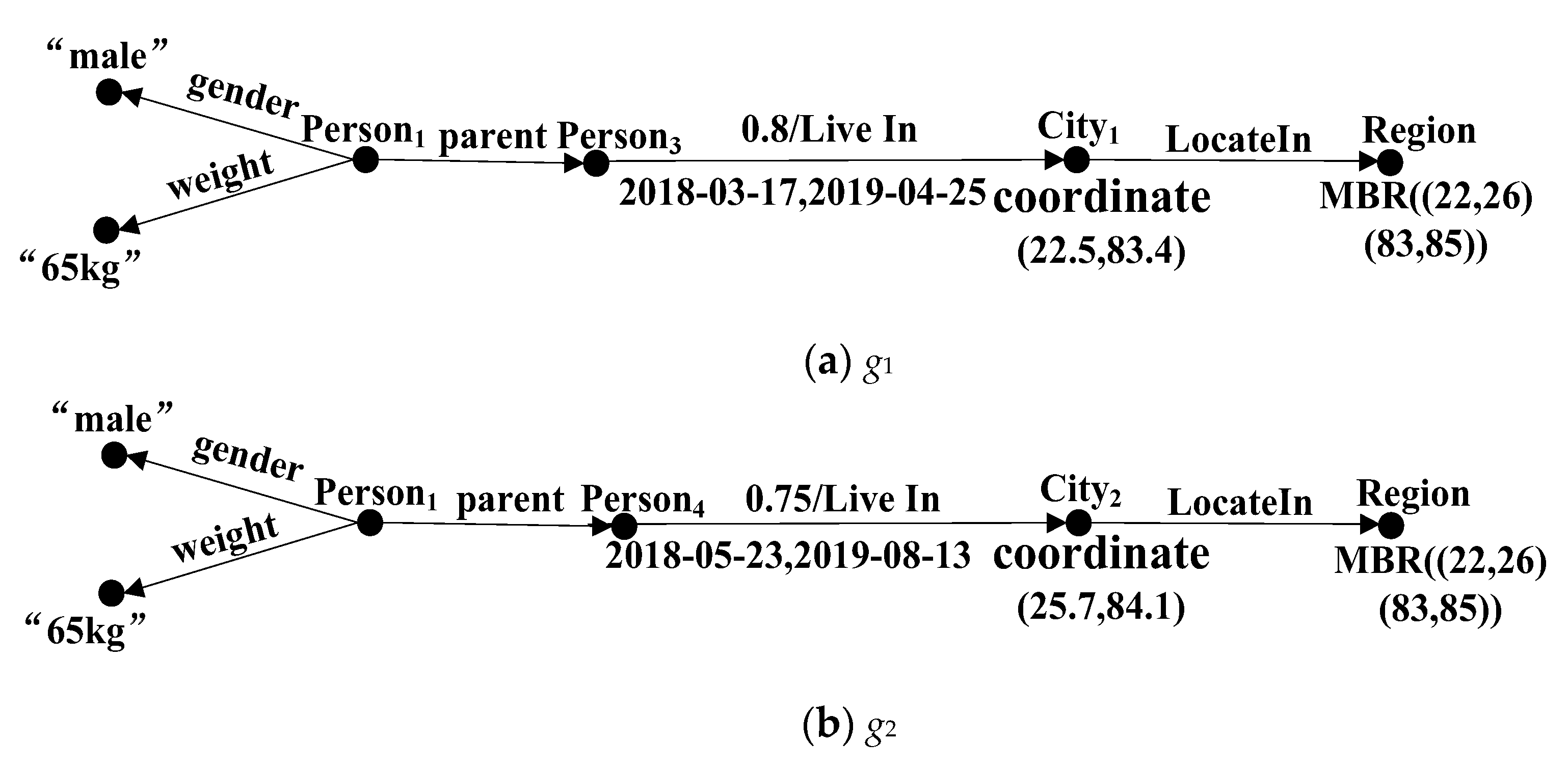Fuzzy Spatiotemporal Data Modeling and Operations in RDF
Abstract
1. Introduction
- (1)
- A fuzzy spatiotemporal RDF information model that considers the spatiotemporal property and fluffiness of RDF information is introduced.
- (2)
- An overall mathematical structure for supporting fuzzy spatiotemporal RDF inquiries is proposed.
- (3)
- Instructions to change SPARQL articulation into mathematical articulation are considered.
2. Fuzzy Spatiotemporal RDF Data Model
- (1)
- If V and E are general vertices and edges, respectively, i.e., nonspatial entities and nontemporal statements, then L: V∪E → Σ1 is the mapping from vertices and edges to Σ1, a collection of labels called the string;
- (2)
- If V is a vertex with the spatial attribute, then S: V → Σ2 is a mapping from vertices to Σ2, a collection of labels called the coordinate;
- (3)
- If E is an edge with the temporal attribute, then T: E → Σ3 is a mapping from edges to Σ3, a collection of labels called the date.
- (1)
- Add vertices vs and vo to V, assign Lv (vs) = s and Lv (vo) = o, and assign Sv (v) = L if the vertex represent a spatial entity;
- (2)
- Add a directed edge (vs, vo) into E, assign Le (vs, vo) = p, and assign Te (vs, vo) = T if the edge has a temporal property.
- (1)
- V is a limited arrangement of vertices;
- (2)
- is a collection of coordinated edges between vertices, where;
- (3)
- Σ = {Σ1, Σ2, Σ3} is a collection of labels, where Σ1 is a collection of general vertices and edges labels, Σ2 is a collection of spatial labels of vertices, and the spatial vertices labels indicate the coordinates of the entities (the events), i.e., the latitude and longitude. Σ3 is a collection of edges with temporal labels, where the labels identify the period time in which the object (the event) happens, i.e., the start time and the end time;
- (4)
- Lv: V → Σ1 is a function that assigns vertices literal labels;
- (5)
- Le: E → Σ1 is a function that assigns edges literal labels;
- (6)
- Sv: V → Σ2 is a function that assigns vertices spatial labels;
- (7)
- Te: E → Σ3 is a function that assigns edges temporal labels;
- (8)
- μ: V → [0, 1] is a fuzzy subset of vertices;
- (9)
- ρ: E → [0, 1] is a fuzzy connection on fuzzy subset μ. Notice that “vi, vj ∊ V, ρ(vi × vj) ≤ μ(vi) ∧ μ(vj), where ∧ represents the minimum value.
- (1)
- and;
- (2)
- ;
- (3)
- .
- (1)
- and
- (2)
- , which is written as G′ ⊆ G.
- (1)
- ,and;
- (2)
- ,,,,, then G1 is isomorphic to G2, which is denoted as G1≅G2.
- (1)
- VP is a finite set of vertexes.
- (2)
- EP is a finite set of directed edges.
- (3)
- FV and SV are functions defined on VP. For a given vertex u ∊VP, FV (u) is the predicate applied to the literal label worth of vertex u. Similarly, SV (u) is the predicate applied to the spatial mark worth of vertex u. These predicates are a Boolean mix of the nuclear predicate, each predicate looks at a steady c determined in the example with the worth Vi using a given operator θ. Let cj be a consistent and θj be a correlation administrator, FV (u) ∨ SV (u) are the mix of nuclear predicates of the structure (Viθjcj) by the intelligent connectives (∧,∨,¬).
- (4)
- FE and SE are functions defined on EP, which are the counterpart of FV and SV for edges.
- (5)
- RE: EP→ re (E) is a capability characterized by EP. For each (u, v) in EP, re (E) is a way of normal articulation, where E is a set that is comprised of the data graph G, variables and wildcard *, which can be developed as R::= e|R1·R2|R1|R2|R+. Here, e denotes the edge labeled by e or wildcard symbol matching any label in Σ, R1·R2 denotes the concatenation of expressions, R1|R2 denotes disjunction of expressions, and R+ denotes one or more occurrences of R.
- (1)
- (Matching vertex) each vertex on VP has a picture vertex on V by the injective capability. Officially, for every vertex u ∈, there is a vertex φ (u) ∈V, associated with a satisfactory degree.
- (2)
- (Matching edge) φ jelly the chart construction of P. For each edge (u, v) ∈ EP, there are two vertices φ (u) and φ (v) of V s.t. There is a path p in G from φ (u) to φ (v) s.t. ρ coordinates standard articulation re with a fulfillment degree, δre (p), characterized as follows, as indicated by the type of re (in the accompanying, R, R1, and R2 are standard articulations):
- If re is an edge labeled by e or a wildcard symbol *, and if p is an edge e′ from vertex φ (u) to φ (v), where then elsethenelse.
- If re is of the form R1 · R2, and P is the set of all pairs of paths (p1, p2) s.t. p is of the form p1p2, then.
- If re is of the form R1|R2 then δre (p) = max (δR1 (p), δR2 (p)).
- If re is of the form R+, and P is the set of all tuples of paths (p1,…,pn) (n > 0) s.t. p is of the form p1 ···pn. One has δre(p) = maxP (min(δR (p1), …, δR1 (pn))).
- (3)
- (Checking conditions on the vertex and edge label) the condition (or predicate) of vertex and edge of P is matched with G. Formally, L(φ(u)) satisfies the formula FV, S(φ(u)) satisfies the formula SV for all u∊ VP, L (φ(u), φ(v)) satisfies the formula FE, T (φ(u), φ(v)) satisfies the formula FE for all (u, v) ∊ EP. If the condition is assessed to be valid, the fulfillment degree is 1, otherwise 0.
- (4)
- The worth of δP (G) is the base worth of the fulfillment degrees coming about because of the matches and conditions in (1), (2), and (3). If there is no match, then δP (G) = 0, i.e., G does not match P.
3. Graph Algebra for Fuzzy Spatiotemporal RDF
3.1. Set Operations
3.2. Fuzzy Spatiotemporal Selection Operation
3.3. Fuzzy Spatiotemporal Projection Operation
3.4. Fuzzy Spatiotemporal Join Operation
3.5. Construction Operations
3.5.1. Vertex Deletion
3.5.2. Edge Deletion
3.5.3. Vertex Insertion
3.5.4. Edge Insertion
4. Relationship of SPARQL Queries and the Fuzzy Spatiotemporal RDF Algebraic Operations
4.1. SPARQL Query in the Fuzzy Spatiotemporal RDF
- (1)
- The keyword Select contains a range of factors that are launched from the fuzzy spatiotemporal RDF information base. SPARQL permits a few types of information to be returned: a table using Select, a chart utilizing Depict or Construct, or a True/False response utilizing Ask.
- (2)
- The watchword indicates the informational collection of a de-issue chart and at least zero named diagrams to question.
- (3)
- The catchphrase Where provision comprises multituple designs as s p o (L T).
- (4)
- The keywords Filter condition contains at least one spatiotemporal predicates. We only take into account WITHIN predicates (for spatial choices), DISTANCE predicates (for spatial joins), and TIME predicates (for temporal choices) in our discourse and models for simplicity’s sake.
- (5)
- The keywords with address the condition should be fulfilled as the base participation degree edge in [0, 1]. Clients pick a proper worth to communicate his/her prerequisite.
4.2. Translating SPARQL Query Pattern into Fuzzy Spatiotemporal RDF Algebraic Formalism
| Algorithm 1. |
| Input: a SPARQL pattern G |
| Output: an algebraic expression A |
| 1: A = φ; F = φ |
| 2: for each syntactic form g in G do |
| 3: if g is triple pattern t then |
| 4: A = (A ⋈ (t)) |
| 5: if g is Optional {P} then |
| 6: A = (A ⋊ Translate (P)) |
| 7: if g is {P1} Union…Union {Pn} then |
| 8: if n > 1 then |
| 9: A′ = (Translate (P1)∪…∪Translate (Pn)) |
| 10: else |
| 11: A′ = Translate (P1) |
| 12: A = (A⋈A′) |
| 13: if g is Filter{R} then |
| 14: F = F∧{R} |
| 15: end for |
| 16: if F ≠ φ then |
| 17: A = σF (A) |
- Select ?x ?p ?z
- From G
- Where {? X ex: weight ?y
- Filter (?y > 60 kg)
- ?x ex: parent ?p
- ?p ex: Live in ?c ?l ?t
- Filter WITHIN (?l, “MBR((22,26)(83,85))”)
- Filter DISTANCE (?l, “coordinate(24,84)”<10 km)
- Filter TIME (?t > data (2018.01.01),?t < data (2019. 12.31))
- Option {? P ex: Married To ?z}}
- With<0.5>.
5. Conclusions
Author Contributions
Funding
Conflicts of Interest
References
- De Virgilio, R.; Rombo, S.E. Approximate matching over biological RDF graphs. In Proceedings of the 27th Annual ACM Symposium on Applied Computing, Trento, Italy, 26–30 March 2012; pp. 1413–1414. [Google Scholar] [CrossRef]
- Breslin, J.G.; Passant, A.; Decker, S. The Social Semantic Web; Springer Science & Business Media: Cham, Switzerland, 2009. [Google Scholar] [CrossRef]
- Suchanek, F.M.; Kasneci, G.; Weikum, G. Yago: A core of semantic knowledge. In Proceedings of the 16th International Conference on World Wide Web, Banff, AB, Canada, 8–12 May 2007; pp. 697–706. [Google Scholar] [CrossRef]
- Bizer, C.; Heath, T.; Berners-Lee, T. Linked data-the story so far. In Semantic Services, Interoperability and Web Applications: Emerging Concepts; IGI Global: Hershey, PA, USA, 2011; pp. 205–227. [Google Scholar] [CrossRef]
- Tan, C.; Yan, S. Spatiotemporal data organization and application research. Int. Arch. Photogramm. Remote Sens. Spat. Inf. Sci. 2017, 42, 1363–1366. [Google Scholar] [CrossRef]
- Kuper, P.V.; Breunig, M.; Al-Doori, M. Application of 3d spatiotemporal data modeling, management, and analysis in db4geo. ISPRS Ann. Photogramm. Remote Sens. Spat. Inf. Sci. 2016, 4, 63–170. [Google Scholar] [CrossRef]
- Vatsavai, R.R.; Ganguly, A.; Chandola, V. Spatiotemporal data mining in the era of big spatial data: Algorithms and applications. In Proceedings of the 1st ACM SIGSPATIAL International Workshop on Analytics for Big Geospatial Data, Redondo Beach, CA, USA, 7–9 November 2012; pp. 1–10. [Google Scholar] [CrossRef]
- Venkateswara, R.K. Spatiotemporal data mining: Issues, tasks and applications. Int. J. Comput. Sci. Eng. Surv. 2012, 3, 39. [Google Scholar] [CrossRef]
- Parrott, L.; Proulx, R.; Thibert-Plante, X. Three-dimensional metrics for the analysis of spatiotemporal data in ecology. Ecol. Inform. 2008, 3, 343–353. [Google Scholar] [CrossRef]
- Theocharidis, K.; Liagouris, J.; Mamoulis, N. SRX: Efficient management of spatial RDF data. VLDB J. 2019, 28, 703–733. [Google Scholar] [CrossRef]
- Gutierrez, C. Introducing time into RDF. IEEE Trans. Knowl. Data Eng. 2006, 19, 207–218. [Google Scholar] [CrossRef]
- Zhang, F.; Wang, K.; Li, Z. Temporal data representation and querying based on RDF. IEEE Access 2019, 7, 85000–85023. [Google Scholar] [CrossRef]
- Wang, D.; Zou, L.; Zhao, D. Gst-store: Querying large spatiotemporal RDF graphs. Data Inform. Manag. 2017, 1, 84–103. [Google Scholar] [CrossRef]
- Mondo, G.D.; Rodríguez, M.A.; Claramunt, C. Modeling consistency of spatiotemporal graphs. Data Knowl. Eng. 2013, 84, 59–80. [Google Scholar] [CrossRef]
- Straccia, U. A minimal deductive system for general fuzzy RDF. In Lecture Notes in Computer Science; Springer: Berlin/Heidelberg, Germany, 2009; pp. 166–181. [Google Scholar] [CrossRef]
- Mazzieri, M.; Dragoni, A.F. A Fuzzy Semantics for the Resource Description Framework; Springer: Berlin/Heidelberg, Germany, 2008; pp. 244–261. [Google Scholar] [CrossRef]
- Zimmermann, A.; Lopes, N.; Polleres, A. A general framework for representing, reasoning and querying with annotated semantic web data. J. Web Semant. 2012, 11, 72–95. [Google Scholar] [CrossRef]
- Ma, Z.; Li, G.; Yan, L. Fuzzy data modeling and algebraic operations in RDF. Fuzzy Sets Syst. 2018, 351, 41–63. [Google Scholar] [CrossRef]
- Prade, H.; Testemale, C. Generalizing database relational algebra for the treatment of incomplete or uncertain information and vague queries. Inf. Sci. 1984, 34, 115–143. [Google Scholar] [CrossRef]
- Melnik, S. Algebraic Specification for RDF Models; IEEE Computer Society: Washington, DC, USA, 1999. [Google Scholar]
- Frasincar, F.; Houben, G.J.; Vdovjak, R. RAL: An algebra for querying RDF. World Wide Web 2004, 7, 83–109. [Google Scholar] [CrossRef]
- Robertson, E.L. Triadic relations: An algebra for the semantic web. In Proceedings of the Second International Conference on Semantic Web and Databases, Toronto, ON, Canada, 29–30 August 2004; pp. 91–108. [Google Scholar] [CrossRef]
- Chen, L.; Gupta, A.; Kurul, M.E. A semantic-aware RDF query algebra. In Proceedings of the COMAD, Hyderabad, India, 20–22 December 2005. [Google Scholar]
- Abidi, A.; Tobji, M.; Hadjali, A. A general framework for querying possibilistic RDF data. In Proceedings of the 2018 IEEE 30th International Conference on Tools with Artificial Intelligence (ICTAI), Volos, Greece, 5–7 November 2018; pp. 158–162. [Google Scholar] [CrossRef]
- Sunitha, M.S. Studies on Fuzzy Graphs. Doctor of Philosophy Thesis, Cochin University of Science and Technology, Cochin, India, 2001. [Google Scholar]








| Num | Fuzzy/Subject | Fuzzy/Predict | Fuzzy/Object | Location (x, y) | Start Time | End Time |
|---|---|---|---|---|---|---|
| #1 | Person1 | Height | 0.95/170 cm | |||
| #2 | Person1 | Gender | Male | |||
| #3 | Person1 | Weight | 0.9/60 kg | |||
| #4 | Person1 | Parent | Person3 | |||
| #5 | Person1 | Parent | Person4 | |||
| #6 | Person2 | Height | 0.9/175 cm | |||
| #7 | Person2 | 0.85/live in | City4 | Coordinate (23.5, 83.6) | 15 August 2018 | 17 November 2019 |
| #8 | Person2 | Gender | Female | |||
| #9 | Person2 | Weight | 0.85/70 kg | |||
| #10 | Person2 | Boss | Person4 | |||
| #11 | Person2 | Brother | Person5 | |||
| #12 | Person3 | Married to | Person4 | |||
| #13 | Person3 | 0.8/live in | City1 | Coordinate (22.5, 83.4) | 17 March 2018 | 25 April 2019 |
| #14 | Person4 | Live in | City2 | Coordinate (25.7, 84.1) | 23 May 2018 | 13 August 2019 |
| #15 | Person5 | 0.8/live in | City3 | Coordinate (24.6, 85.4) | 9 June 2018 | 4 September 2019 |
| #16 | City1 | Located in | Region | MBR ((22, 26) (83, 85)) | ||
| #17 | City2 | Located in | Region | MBR ((22, 26) (83, 85)) |
| Original SPARQL Syntax | Algebraic Syntax |
|---|---|
| P1 ⋈ P2 | |
Publisher’s Note: MDPI stays neutral with regard to jurisdictional claims in published maps and institutional affiliations. |
© 2022 by the authors. Licensee MDPI, Basel, Switzerland. This article is an open access article distributed under the terms and conditions of the Creative Commons Attribution (CC BY) license (https://creativecommons.org/licenses/by/4.0/).
Share and Cite
Zhu, L.; Meng, X.; Mi, Z. Fuzzy Spatiotemporal Data Modeling and Operations in RDF. Information 2022, 13, 503. https://doi.org/10.3390/info13100503
Zhu L, Meng X, Mi Z. Fuzzy Spatiotemporal Data Modeling and Operations in RDF. Information. 2022; 13(10):503. https://doi.org/10.3390/info13100503
Chicago/Turabian StyleZhu, Lin, Xiangfu Meng, and Zehui Mi. 2022. "Fuzzy Spatiotemporal Data Modeling and Operations in RDF" Information 13, no. 10: 503. https://doi.org/10.3390/info13100503
APA StyleZhu, L., Meng, X., & Mi, Z. (2022). Fuzzy Spatiotemporal Data Modeling and Operations in RDF. Information, 13(10), 503. https://doi.org/10.3390/info13100503






